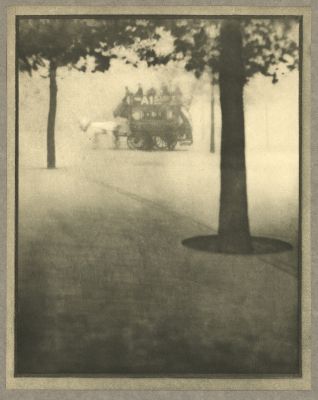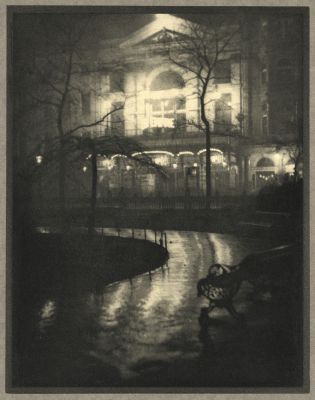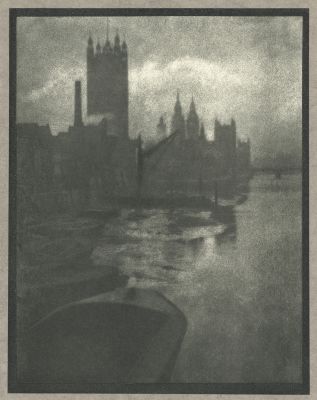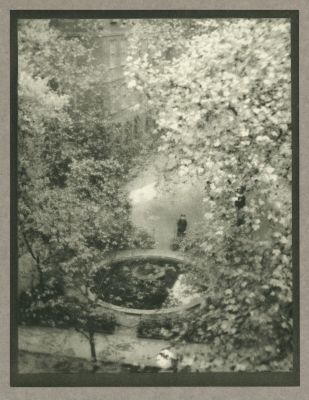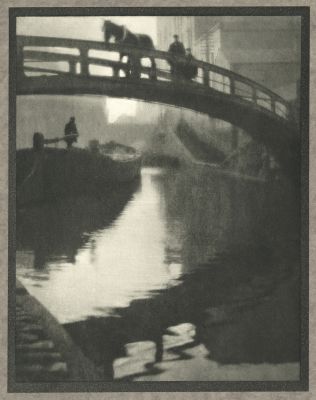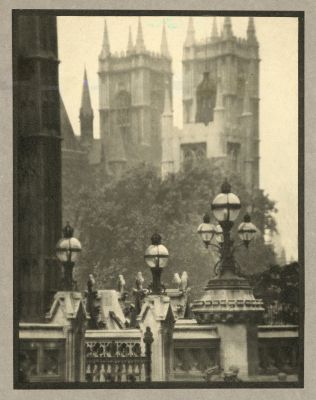
Title
London BridgeArtist
Coburn, Alvin Langdon (American, 1882-1966)Key FigurePublication
LondonDate
1910Process
PhotogravureAtelier
Alvin Langdon CoburnImage Size
20.7 x 16.8 cm
"He [Coburn] was the most important American photographer of his generation to expend significant energy on illustrating books." Looking for beauty in unlikely surroundings, Coburn would wait all day, revisiting the same spot for several days, to find that perfect consummation of light, self-expression and mood, and was happier photographing in London fog, which required ten minutes exposure at noon, than sunshine. In the case of his London Bridge (Bridge Sunlight) image, he claimed, "I worked nearly a year to get that London Bridge… in the [1905 London] Salon. Reviews agreed: "His one view of London Bridge which was singled out as the most notable architectural study of the last year’s exhibition season had an exposure of nearly a year… he was working on the bridge, studying it and making picture after picture until… eventually he obtained a position (on the top-most floor of one of the great riverside warehouses) and waited for the lighting which gave him exactly the picture he required." His London pictures are obviously and startlingly recognizably London, but taken from a viewpoint that few others had seen. Roberts p. 27
According to the British writer, George Bernard Shaw: "This collection of photographs of London has been in preparation by Mr. Coburn for the past five years, but technically they represent the latest development of his art. Recognizing… that in photogravure he has now, as the impressions in this volume show, produce prints comparable to his finest achievements in gum-platinotype, but reproduce them with a certainty at a cost which makes such a publication as the present possible."
London is Coburn’s first, groundbreaking photo book. The 20 elegant hand-pulled photogravure plates are tipped onto rich gray paper and were prepared by Coburn himself. Poised at a crucial turning point in the history of photography, representing the transition from pictorialism to modernism, this work illuminates the concern of the more advanced pictorialist with ‘modern’ subjects, namely the 20th-century city—a shift in attitude that triggered the final push towards photographic modernism. [1].
Boston-born Coburn based himself in London from around 1906, learning how to make photogravures at the London County Council School of Photo-engraving, and establishing a studio with two copperplate printing presses at the home he shared with his mother in Hammersmith. "In the period 1909-14 he etched and steel-faced eighty-three plates, and oversaw the printing of some 40,000 hand-pulled gravures." His first two publications London (1909) and New York (1910), were intended as the start of a series, exploring "the adventures of cities" each containing twenty luscious hand-pulled photogravures. A key member of Alfred Stieglitz’ Photo-Secession and a friend of many Cubists, "Coburn had one foot in the 19th century and one foot in the 20th century. [2]
References
[1] Parr Martin and Gerry Badger. The Photobook : A History. Phaidon 2004 2014. Vol I, p. 74
[2] Roth Andrew et al. The Book of 101 Books : Seminal Photographic Books of the Twentieth Century. PPP Editions in Association with Ruth Horowitz LLC 2001. p. 38
Roberts, Pamela Glasson Coburn Alvin Langdon Pamela Glasson Roberts Fundación Mapfre and George Eastman House. 2014. Alvin Langdon Coburn. Madrid: Fundación Mapfre.
